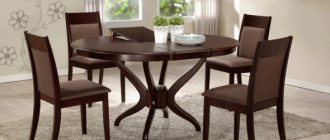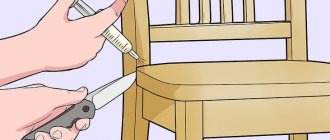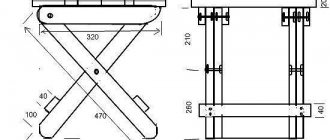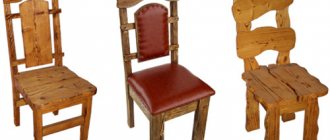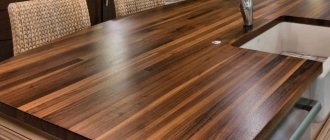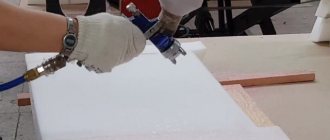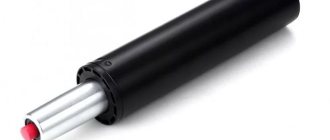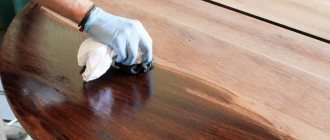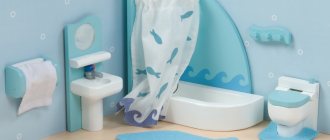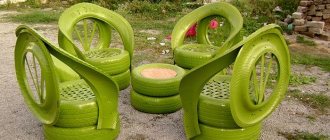When choosing a good glue for furniture, you need to focus on what materials need to be glued. Often furniture parts are small pieces with a small area for fixation, therefore, the glue must provide an even and strong seam. The last choice will be color. Furniture as an interior item should be neat; there is no place for colored seams or glue smudges.
How to glue a dried out wooden chair
Wooden chairs not only have an attractive appearance, comfort, and exquisite design, but are also highly durable and environmentally friendly.
Unfortunately, over time, such chairs tend to wear out, dry out, become damaged, or their legs simply become loose. Unlike plastic products, they consist of many small parts that are connected with special glue and several tools. If your chair is drying out, you've probably asked yourself the following questions: how to glue it yourself at home, what kind of glue to choose for quality, and how to do the job correctly.
Urea resin
Urea resin adhesive is prepared from thiourea or synthetic urea through a heating process. Such compositions create very strong compounds of wood products. They are resistant to moisture and can be used in extreme conditions.
This glue is acid-curing, and after mixing with a hardener its service life is short - up to 4 hours. It is used for hot pressing.
Reference! This glue is transparent, which is very beneficial when gluing wooden furniture.
Choosing glue for wooden chairs
To know how to properly glue a wooden chair, experts recommend choosing high-quality glue according to the following characteristics:
- light fastness;
- water resistance;
- absence of traces on the surface;
- connection strength.
Popular adhesives among craftsmen are PVA, BF, epoxy, syndeticone, polyurethane and others. Each of them has a number of specific advantages for sealing a wooden chair:
- PVA has an unlimited shelf life, acts quickly and is non-toxic.
- Epoxy adhesive has versatility of use and strong adhesion. It is popular due to its strong connection of various materials.
- BF has high moisture resistance and quick drying.
- Syndeticone durable adhesive can withstand high loads, is resistant to liquids and aggressive compounds.
- Polyurethane waterproof adhesive is used for gluing various materials. It is physically and chemically inactive to different temperatures, ultraviolet radiation, moisture, and is resistant to stress.
Which glue is best for gluing wood and structures made from it is a question that depends on the wishes and budget of the craftsmen.
Varieties
Several types of adhesives have been identified, differing in purpose. Each has a high drying strength. Varieties:
- Water-based - PVA, animal. Designed for fixing fabric bases of furniture, foam elements, non-woven fibers. When attaching such bases, other types are not suitable, as they can damage the surface (superglue can corrode the fabric.
- Carpentry (resorcinol). Made from aliphatic resins. Used for gluing wooden elements. Subsequently, the glued product can be used outdoors.
- Contact – rubber-based, thermal, PVA of special strength. Purpose: repair, restoration of furniture that is used indoors and outdoors. It sets quickly, but it dries completely within a day.
Several types are distinguished according to the principle of solidification:
- Quick drying. These include PVA; it is enough to leave the glued element in a ventilated area for rapid gluing to occur.
- Hot melt adhesives. They are produced in the form of granules, cartridges, etc. To activate the functions, it is enough to bring them into a liquid state by heating.
- Thermosetting. Bonding occurs under the influence of increased temperatures. This type is divided into single-component (ready to use immediately) and multi-component (requires preparation before application).
Depending on the form of production, adhesive masses are liquid, solid, or dry.
Furniture adhesive containing a solvent quickly fixes and dries due to the evaporation of the volatile substance. Water-based bases are glued over a longer period.
Interesting video on the topic:
Leg gluing and complete repair
The legs of a wooden chair can be glued with fresh glue that meets the specified characteristics. You should also stock up on a hammer with a rubber tip, sandpaper, a press and a chisel. Simple repairs are carried out in several stages:
- You should pull out the loose leg and clean the remaining old glue from the part where the product is loose.
- Fresh glue is applied to the leg, inserted back into the seat, and then sealed.
- It is necessary to place a press on the seat, remove the remaining glue and hold the parts to be glued for the time indicated on the glue packaging.
When asked how to glue a chair that has cracked in other places, you should first carefully disassemble the damaged parts. Repairing a chair with a drawer (frame connecting the legs of the chair) is considered difficult, since all the parts are glued and connected with a tenon groove. After disassembling the loose parts, it is necessary to clean the seams and apply glue to the joints. If the seam diverges, just drill a good hole and inject glue with a syringe.
If it is impossible to pull out the loose element, you should stretch the frame further and inject the adhesive into the groove. For strong stability, a narrow wedge can be inserted into the trunnion socket and secured with glue.
Purpose
Furniture glue can be used during different processes:
- direct production of interior items. Often people prefer to install environmentally friendly and unique structures created with their own hands in their homes. To do this, a drawing is formed, parts are prepared, and then they are connected with fasteners or glued together using high-quality glue. In this case, it is necessary to take into account what material the product is made of, since the correct choice of adhesive substance depends on this;
- repair of furnishings. Often high-quality models break due to significant impact or other factors. They can be repaired independently in different ways, but often only gluing individual elements is suitable. A special furniture glue is suitable for this. It is recommended to work with it with a special tool, due to which it is possible to apply the substance to the most inaccessible areas of the object.
Using high-quality and reliable furniture glue has many advantages:
- for any material, you can choose a special composition that is ideally suited to the structure and characteristics of the surface, therefore, ideal and reliable bonding of coatings is guaranteed;
- a highly elastic adhesive seam is formed;
- it is advisable to choose a waterproof product that can easily withstand exposure to moisture and does not lose its properties and adhesive parameters;
- high-quality and reliable compositions gain maximum strength in just 6 or 8 hours;
- It’s really easy to use this glue, so anyone without the appropriate experience or specific skills can handle furniture repair.
A significant point is the competent choice of the adhesive substance itself, for which the characteristics of the surfaces to be glued and the operating conditions of the furnishings are taken into account.
Furniture glue is necessary to connect structural elements
Additional gluing points
Experts recommend thoroughly cleaning the connecting areas, which are subsequently glued together. If the old glue is difficult to scrape off, apply warm vinegar or solvent to the cleaning area.
To securely secure the structure, many craftsmen, after gluing the parts, use a tension belt or clamp to press tightly and dry quickly.
If, after repairing the structure, creaks and other problems remain, and the seals did not help, it is advisable to use the services of professionals and contact a workshop for help.
Possible mistakes
Often, after gluing, furniture continues to sway and squeak. If the chair falls apart, the procedure was carried out in violation of technology. Let's look at the main culprits of the problem.
The composition has not dried
The drying time of most modern adhesives is up to 24 hours. Even if the manufacturer promises availability on the label in 30 minutes, this is a setup period. The composition gains strength within 24 hours after application.
External factors may prevent the adhesive from curing. Products dry slowly at low temperatures and high humidity. If you need to quickly make repairs, in the cold season it is better to move the furniture to a warm room after gluing.
Violation of technology
To ensure that the glue adheres well, the surface is prepared before application. Old residues are removed from the wooden chair parts and then degreased with alcohol. Professionals recommend making small cuts with a knife in the transverse plane of the spine. The method will make it easier to join the parts.
The glue may dry before the connectors touch. Wood absorbs excess moisture, especially indoors in hot summers or heat. If the performer maintains the composition, the product does not have time to act on the surface.
The glue won't stick if it's loose. In order for a wooden chair to stick, the structure must be secured. Carpenter's clamps (collars) or rubber bands will help hold the parts in place. The structure is dismantled one day after treatment.
Glue should not get into the seams. To glue a wooden chair, it is necessary to dismantle the problematic part and adjacent elements. The mass should penetrate accurately and generously into the furrow and tip. Without dismantling, even the most durable composition will not cope with the task.
The product was chosen incorrectly
If the mass does not stick, it means that the wrong glue was used for the wooden chair. Universal compounds also have a list of surfaces with which they work. A leather, glass or plastic cleaner will not necessarily restore wood. You should not experiment with building materials - it is prohibited to use polyurethane foam or grout for furniture tiles.
Types of glue that we will consider in the article:
- PVA
- Epoxy
- BF
- Heat resistant for wood
- Polyurethane
- Syndeticone
- Carpentry
- Casein
- Adhesive pastes
Let's talk about each type of glue in more detail.
Polyvinyl acetate glue or PVA glue
For wood, PVA glue works great. It is non-toxic and generally harmless to human health. Withstands a good load, about 60 kg/1cm2. The shelf life of PVA glue is unlimited. Application is easy.
How to glue a wooden chair
Not every glue is used to fasten wood elements.
For furniture repair, substances are selected that meet the following requirements:
- water resistance;
- high adhesive properties - the factor contributes to the formation of a reliable seam;
- transparency - such glue, when dry, will not leave stains on the surface of the chair;
- high drying speed;
- environmentally friendly composition - the presence of toxic substances in the glue makes it undesirable
- use at home.
Many types of glue have these qualities; the most suitable for processing wooden furniture are:
Each of these options has its own characteristics and advantages. PVA glue has an unlimited shelf life and low price. In addition, it is completely non-toxic.
The advantage of the BF composition is that it dries quickly and can be used for items that are located in conditions with high humidity. This could be kitchen or bathroom furniture.
Many craftsmen prefer epoxy glue. What is attractive about this composition is its versatility. In addition to restoring wooden furniture, it can be used for any repair work.
Polyurethane adhesive has a wide range of applications. Its positive qualities are high resistance to temperature changes, moisture, ultraviolet rays and stress.
Syndeticone glue forms very strong connections. This composition is used for structures subject to high loads. This could be children's furniture, which rarely manages to be handled with sufficient care.
When choosing one or another product, you should be guided by the personal preferences and financial capabilities of the home craftsman. Most professional restorers recommend using PVA glue, but when purchasing, you need to pay attention to the country of manufacture and brand of the composition.
“Carpentry” and plasticized dispersions D40P-D53P are considered the most successful for woodworking.
Let's watch a video about adhesives that can be used for carpentry:
Mode of application
List of recommendations to consider when working with furniture glue:
- First of all, you need to read the instructions included with the composition. From it you can find out whether it is suitable for the material used and how the gluing occurs.
- It is important to become familiar with the composition of the glue and pay attention to the presence of toxic substances (trichloroethane is especially dangerous).
- Work with toxic types of glue should be carried out outdoors or in a well-ventilated area.
- The surfaces to be bonded are thoroughly cleaned of dust and dirt and must be completely dry. In most cases, moisture will prevent the adhesive from fully setting.
- Many types of glue are yellow, white, or other tints. When using this fact, you need to take this fact into account or choose a colorless option. Opaque furniture glue will be visible even under a layer of varnish or stain.
- The glue is most often applied in a small layer on both surfaces to be glued. After this, they must be connected and pressed tightly against each other.
Important! Some two-component compositions involve applying the base to one surface and the hardener to the other. In this case, the chemical reaction begins after the parts are combined. This allows you to achieve the maximum level of connection strength.
Repairing a wooden chair: how to glue wood tightly
First of all, loosen nodes are separated. Sometimes you have to completely disassemble the chair to carry out work. This should be done carefully so as not to damage the grooves.
If you only need to glue one leg, complete disassembly is not necessary.
Next, remove the remnants of old glue from the surface of the spikes or dowels. This procedure is performed with a knife or chisel. If the old composition does not come off, the parts can be doused with hot water steam. The desired effect is also achieved using vinegar or solvent.
Then, using sandpaper, the wooden surfaces are cleaned of dried glue. The resulting chips and dust are wiped with a damp piece of cloth.
It is important to consider that the key to reliable gluing is high-quality cleaning of surfaces.
The next step is to apply glue, and the elements of the chair are inserted into the corresponding grooves and hammered in until they stop. If the element cannot be pulled out completely, glue is injected into the groove using a syringe.
Epoxy
Epoxy glue is universal, capable of gluing any surface, including wood. It can smooth out unevenness, quickly filling all cavities.
The material is a two-component mixture consisting of resin and hardener, which does not require preheating before application.
Basic properties:
- heat resistance;
- elasticity;
- completely waterproof;
- immunity to aggressive environments;
- good adhesion;
- resistance to cracking.
Epoxy compounds have disadvantages. The main disadvantage is the high hardening speed.
You need to work with the composition quickly and accurately. It must be borne in mind that if mistakes are made, it will be impossible to correct them.
